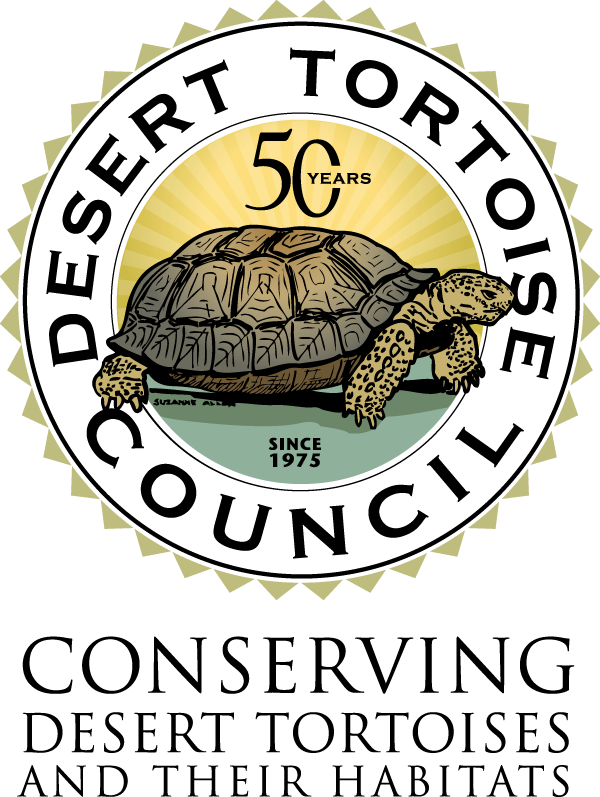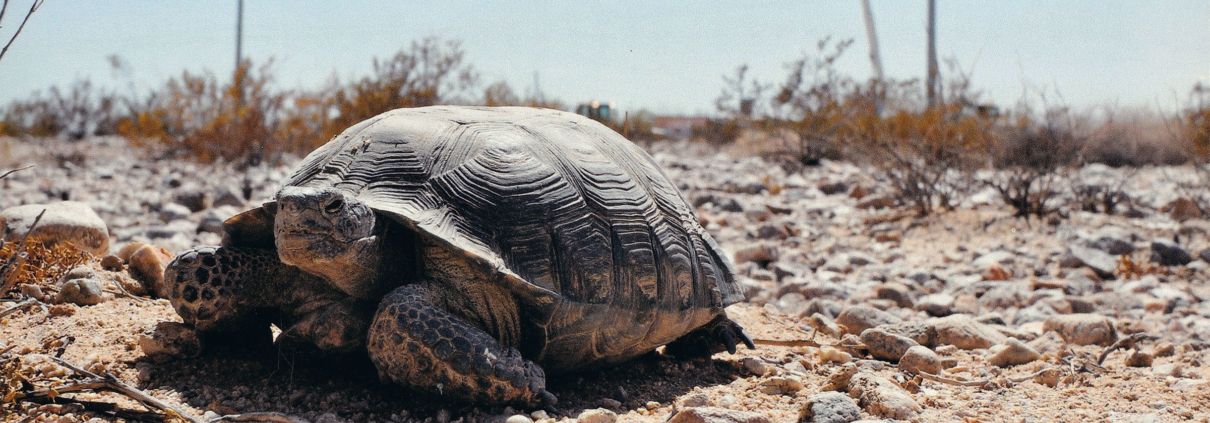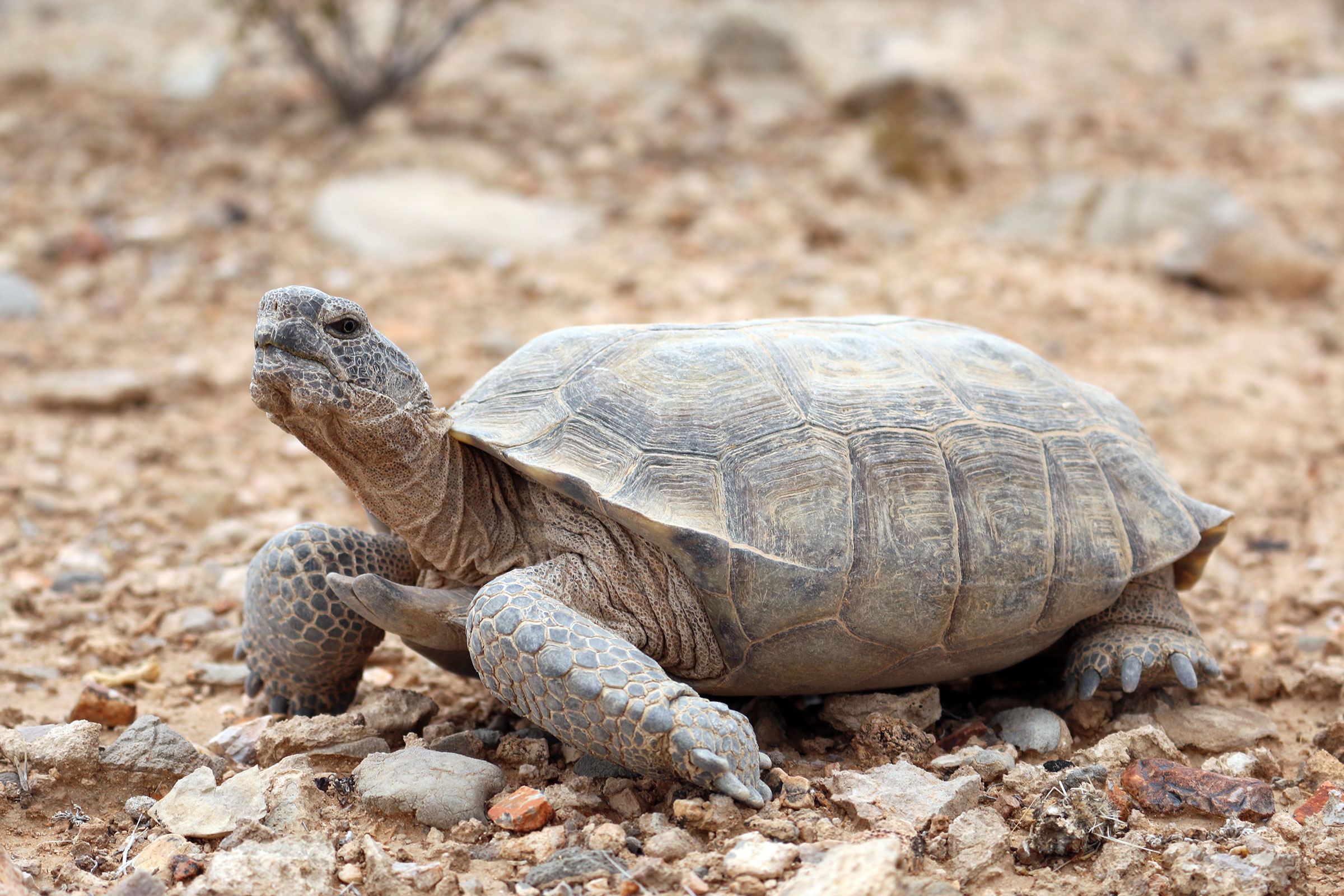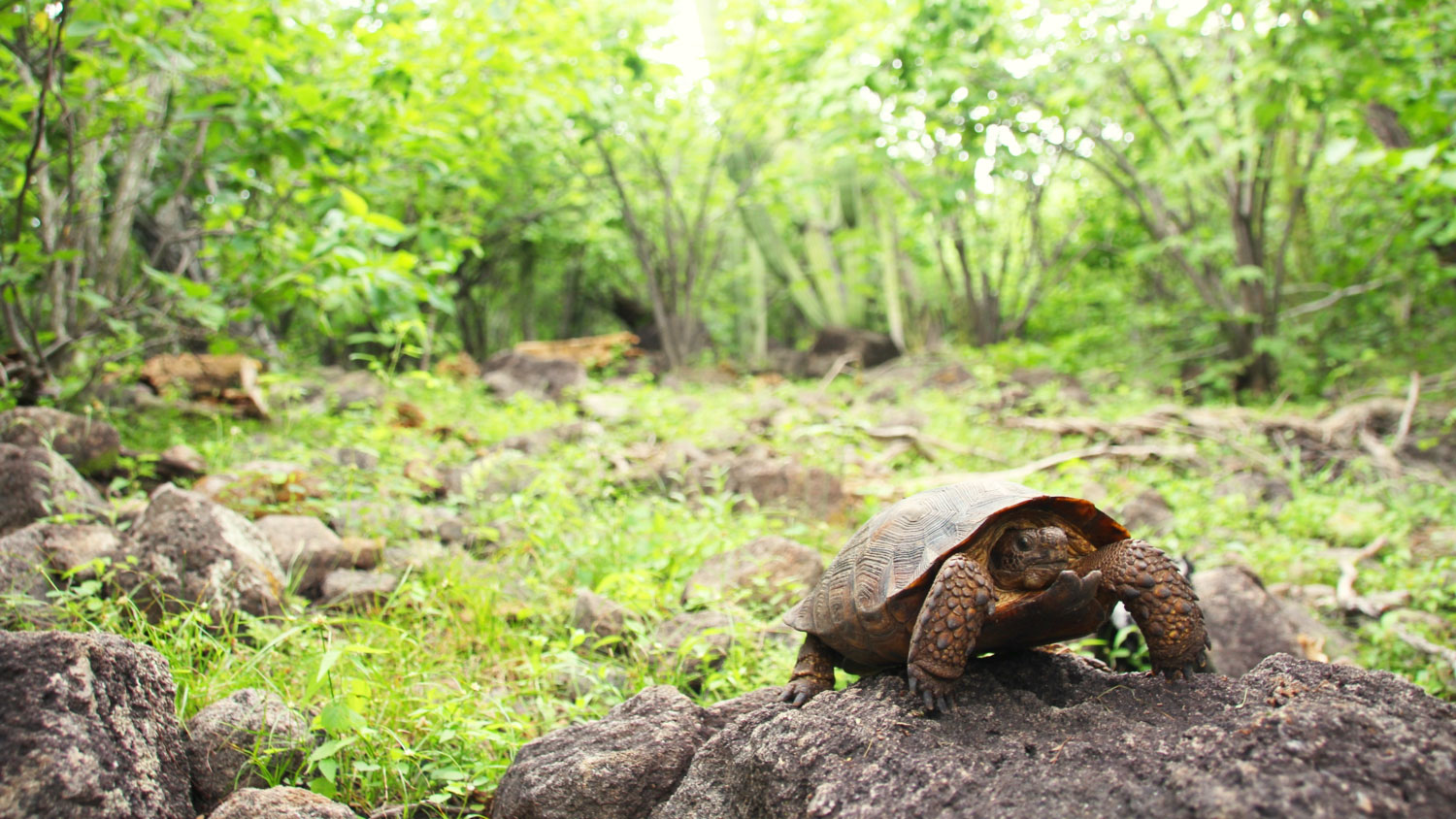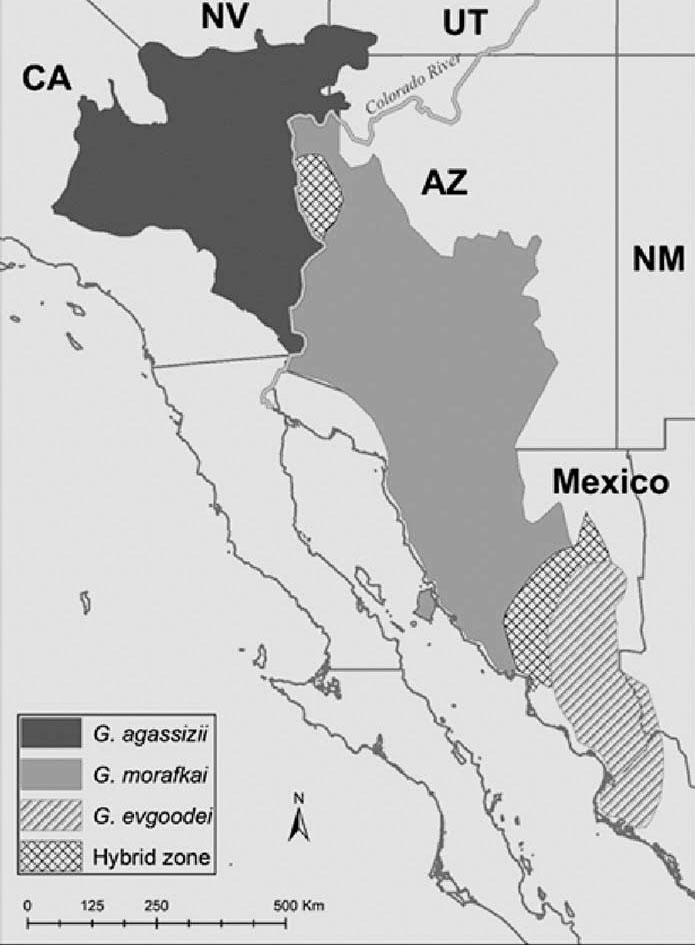Biology of Desert Tortoises
There are three species of desert tortoises, including Agassiz’s desert tortoise, Morafka’s desert tortoise, and Goode’s thornscrub tortoise, are native inhabitants of several southwestern ecosystems, including the Sonoran, Colorado, and Mojave Deserts of the southwestern United States and northwestern Mexico, and tropical deciduous forests and thornscrub in northwestern Mexico. Each are described further below.
Agassiz’s Desert Tortoise
Agassiz’s desert tortoise (Gopherus agassizii; also called Mojave desert tortoise) is a medium-sized tortoise that occupies desert scrub habitats in desert valleys and on bajadas in the Mojave and Colorado Deserts in California, Nevada, Arizona, and Utah in the United States. The species is an adept burrower, and retreats to cover sites, such as self-excavated burrows, caliche caves, and rockshelters, where it spends more than 95% of its time to avoid harsh desert conditions. Shrubs, especially creosote bushes, are important habitat for Agassiz’s desert tortoises, and are used as shade resources to avoid the hot desert sun. Agassiz’s desert tortoises brumate in their cover sites during the winter, generally between early November through mid-March. They are active on the surface between mid-March through October, during which time they forage, breed, and maintain social structures. Agassiz’s desert tortoise forage primarily on annual wildflowers, and secondarily on grasses and cacti. Most of their caloric intake occurs in April and May, when winter annual wildflowers are abundant and available. In parts of their range, Agassiz’s desert tortoises forage on summer annual wildflowers that germinate after monsoon rains. Female Agassiz’s desert tortoises nest in early April through mid-June, and can lay up to three clutches during this time. They typically excavate the nest and deposit their eggs just inside the tunnel of their burrows, or on the ‘apron’ or mound of excavated dirt deposited just outside of the burrow. Hatchlings emerge from nests in August and September. Agassiz’s desert tortoises are generally less active in June, when forage plants have dried up and daytime temperatures soar. They are activated during monsoonal storms between early July through September, when they can drink and replenish their urinary bladders with fresh water that they use for metabolic processes for the remainder of the year. The breeding season for Agassiz’s desert tortoises peaks in August and September, when blood testosterone levels are highest in males. Agassiz’s desert tortoises are very social, and both males and females maintain dominance hierarchies. Male tortoises coinhabit cover sites with other males and females, but female tortoises generally do not coinhabit cover sites.
Agassiz’s desert tortoise populations have declined markedly in recent decades due to a variety of threats that cause mortality to tortoises and eliminate, degrade, or fragment their habitats. Threats that cause mortality to tortoises include vehicle strikes on roads, railroads, and construction sites, disease, predation by subsidized predators (predators whose populations have increased due to their partial reliance on human food, water, and shelter subsidies), and collection by humans for food or pets. Threats that destroy or degrade tortoise habitat include urbanization, development of roads, transmission lines, and pipelines, agriculture, livestock grazing, military training, off-road vehicle recreation, and illegal dumping, among many others.
Agassiz’s desert tortoise is listed as Threatened on the Endangered Species Act. Under this law, take of Agassiz’s desert tortoise is prohibited. The term “take” means to harass, harm, pursue, hunt, shoot, wound, kill, trap, capture, or collect, or to attempt to engage in any such conduct (section 3(19), federal Endangered Species Act of 1973, as amended). Possession of a wild Agassiz’s desert tortoise is prohibited, as possession is included under capture or collect. In addition, it is unlawful to deliver, receive, carry, transport, or ship in interstate or foreign commerce, by any means whatsoever, and in the course of a commercial activity, any endangered or threatened wildlife (50 Code of Federal Regulations 17.21(e) and 50 Code of Federal Regulations 17.31(a)). In addition, 50 Code of Federal Regulations 10.12 defines wildlife to mean any wild animal, whether alive or dead, including without limitation any wild mammal, bird, reptile, amphibian, fish, mollusk, crustacean, arthropod, coelenterate, or other invertebrate, whether or not bred, hatched, or born in captivity, and including any part, product, egg, or offspring thereof. The federal Endangered Species Act protects Agassiz’s desert tortoises in California, Nevada, Utah, and – for populations that occur west of the Colorado River – Arizona. Populations of Agassiz’s desert tortoise located east of the Colorado River in Arizona are not currently protected under the federal Endangered Species Act but are nonetheless protected under state law (see below).
In Arizona, Agassiz’s desert tortoises are protected under Arizona Revised Statute (ARS) 17-306, which states that it is unlawful to release wildlife (including Agassiz’s desert tortoises) in Arizona without prior approval from the Commission/Arizona Game and Fish Department. ARS 17-309 establishes the penalty for a violation. Per Arizona Administrative Code R12-4-402, it is unlawful to import, export, or offer to sell live wildlife, including Agassiz’s desert tortoises. It is unlawful to propagate captive Agassiz’s desert tortoises or export an Agassiz’s desert tortoise from Arizona.
In California, Agassiz’s desert tortoise is listed as Threatened under the California Endangered Species Act. In general, it is illegal to sell, purchase, harm, take, possess, transport, or shoot a projectile at Agassiz’s desert tortoises in California, or to move them out of the State. (California Fish and Game Code, Division 5. Protected Reptiles and Amphibians, Article 1. Desert Tortoises [5000 – 5002]).
In Nevada, Agassiz’s desert tortoise is protected under Nevada Revised Statute (NRS 501.100), and Nevada Administrative Code (NAC 503.080). Agassiz’s desert tortoises in Nevada are considered wildlife (NRS 501.097) and belong to the people of Nevada (NRS 501.100).
In Utah, Agassiz’s desert tortoise is protected under Utah Administrative Rule (R657-53), which prohibits the removal or harm of any desert tortoise from the wild as well as possession, propagation, or importation of desert tortoises. The release of captive desert tortoises to the wild is illegal in Utah.
Morafka’s Desert Tortoise
Morafka’s desert tortoise (Gopherus morafkai; also called Sonoran desert tortoise) is a medium-sized tortoise that occupies desert scrub habitats on rocky hillsides and bajadas in the Sonoran Desert in Arizona, United States and Sonora, Mexico. Like other Gopherus species, the species is an adept burrower, but it primarily retreats to rockshelter cover sites, and secondarily to caves and self-excavated burrows. The species spends more than 95% of its time in cover sites to avoid harsh desert conditions. Shrubs, especially creosote bushes, are important habitat for Morafka’s desert tortoises, and are used as shade resources to avoid the hot desert sun. Morafka’s desert tortoises brumate in their cover sites during the winter, generally between early November through mid-March. They are active on the surface between mid-March through October, during which time they forage, breed, and maintain social structures. Morafka’s desert tortoise forage primarily on annual wildflowers, and secondarily on grasses and cacti. Female Morafka’s desert tortoises typically nest in April and lay one clutch of eggs. Morafka’s desert tortoises are generally less active in June, when forage plants have dried up and daytime temperatures soar. They are activated during monsoonal storms between early July through September, when they can drink and replenish their urinary bladders with fresh water that they use for metabolic processes for the remainder of the year. The breeding season for Morafka’s desert tortoises peaks in August and September, when blood testosterone levels are highest in males. Morafka’s desert tortoises are very social, and both males and females maintain dominance hierarchies.
Morafka’s desert tortoise populations appear to be stable in Arizona. Less is known about their populations in Mexico. Because of their slow growth, late maturity, and low fecundity, Morafka’s desert tortoises are susceptible to population decline during periods of increased mortality, as well as through loss of habitat. In Arizona, their threats are primarily fragmentation of habitat due to the development of roads and urbanized areas. Collection by humans for food may be a serious threat for populations in Mexico.
Morafka’s desert tortoises are listed under the Endangered Species Act under 50 Code of Federal Regulations 17.51 because of their “similarity of appearance” to Agassiz’s desert tortoises. As such, they are treated as Threatened (50 Code of Federal Regulations 17.51) when found outside their native range in Arizona and Mexico (50 Code of Federal Regulations 17.11(h)).
In Arizona, Morafka’s desert tortoises are a state protected species, and Arizona Game and Fish Commission Order 43 has prohibited the removal of Sonoran a desert tortoise from the wild since 1988. Under Arizona Revised Statute (ARS) 17-306, it is unlawful to release wildlife (this includes Morafka’s desert tortoise) in Arizona without prior approval from the Commission/Arizona Game and Fish Department. ARS 17-309 establishes the penalty for a violation. Per Arizona Administrative Code R12-4-402, it is unlawful to import, export, or offer to sell live wildlife, including Morafka’s desert tortoises. It is unlawful to propagate captive Morafka’s desert tortoises or export a desert tortoise from Arizona.
In Mexico, Morafka’s desert tortoise is protected under the General Wildlife Law (LGVS), which stipulates in Article 56 that the Ministry of Environment and Natural Resources (SEMARNAT) identifies through lists, the species or populations at risk, in accordance with Mexican federal list of endangered species (Norma Oficial Mexicana) NOM-059 SEMARNAT 2010. Morafka’s desert tortoises are listed as Category A “Amenazada” (Threatened) and are thus protected from collection and certain human activities under this law.
Goode’s Thornscrub Tortoise
Goode’s thornscrub tortoise (Gopherus evgoodei; also called Sinaloan thornscrub tortoise) is a medium-sized tortoise that occupies hills and low mountains with large boulders or rock outcrops in relatively mesic Sinaloan thornscrub and tropical deciduous forest habitats in Sonora and Sinaloa, Mexico. Little is known about the biology of this species. Like other Gopherus species, the species may be an adept burrower, but it appears to primarily retreat to rockshelter cover sites. It burrows under boulders or rock cavities on hillsides and rock outcrops. In flatter areas where boulders are not be available, it digs shallow soil burrows. Goode’s thornscrub tortoises are also known to seek cover in packrat middens, beneath dry cacti, or in burrows excavated by other animals. The species is likely most active during the wet season, or between July and November. Little is known about daily activity patterns, reproduction, movements, or foraging behaviors in Goode’s thornscrub tortoise.
Little is known about the conservation status of Goode’s thornscrub tortoise populations. Because of their slow growth, late maturity, and low fecundity, Goode’s thornscrub tortoises are susceptible to population decline during periods of increased mortality, as well as through loss of habitat. Collection by humans for food may be a serious threat for populations in Mexico. Conversion of native thornscrub to buffelgrass pasture poses the greatest threat to loss of Goode’s thornscrub tortoise habitat.
Goode’s thornscrub tortoise is protected under the General Wildlife Law (LGVS), which stipulates in Article 56 that the Ministry of Environment and Natural Resources (SEMARNAT) identifies through lists, the species or populations at risk, in accordance with Mexican federal list of endangered species (Norma Oficial Mexicana) NOM-059 SEMARNAT 2010. Goode’s thornscrub tortoises are listed as Category A “Amenazada” (Threatened) and are thus protected from collection and certain human activities under this law.
